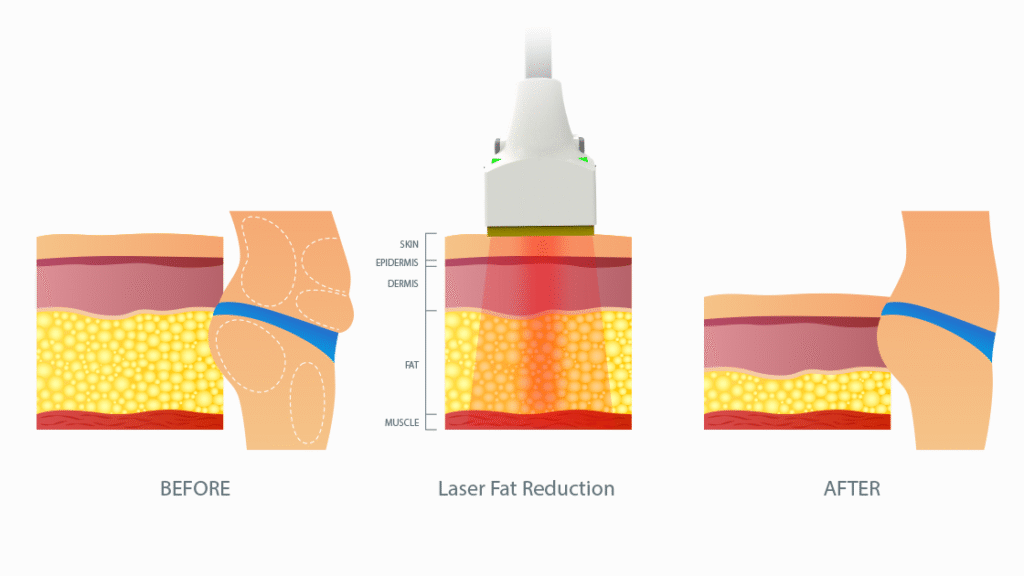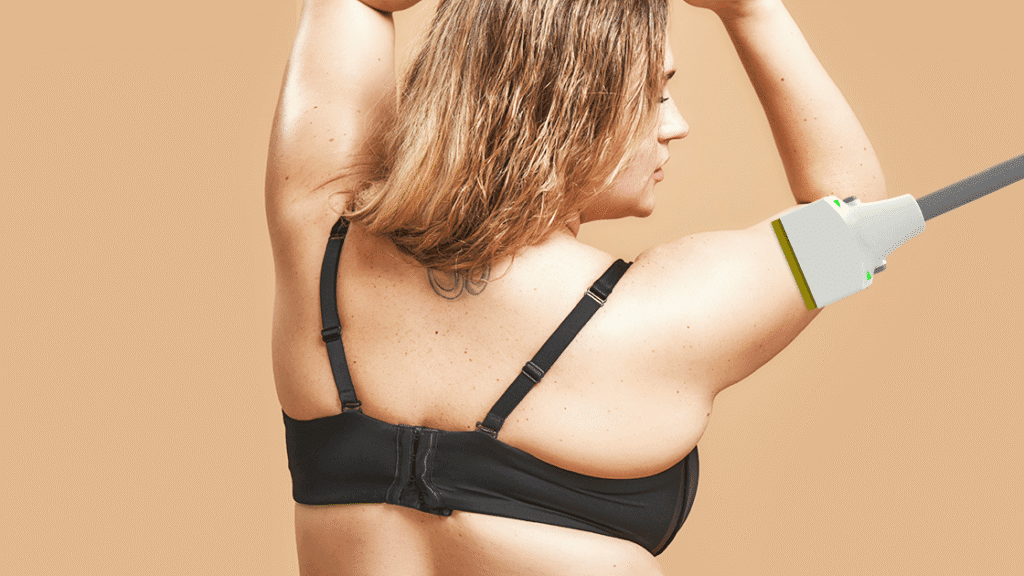1. Introduction: The Shift Toward Non-Surgical Body Contouring
In 2025, non-invasive body contouring has become a leading trend in aesthetic medicine, driven by rising demand for safer, more convenient treatments. The global market for non-invasive fat reduction is projected to reach USD 4.3 billion by 2030, growing at a 16.2% annual rate. This shift reflects a broader change in patient preferences—today’s consumers want effective, low-risk procedures that fit into busy lifestyles. Laser lipolysis, in particular, has emerged as a top choice, offering targeted fat reduction without surgery, anesthesia, or extended downtime. Combining safety, efficiency, and visible results, it has quickly gained traction among both patients and practitioners. This article explores why laser lipolysis is leading the non-surgical fat removal movement and how it is transforming modern aesthetic care.
1.1 Changing Preferences: Why Patients Are Avoiding Surgical Liposuction
Today’s patients are increasingly steering away from traditional liposuction due to its invasiveness, surgical risks, and long recovery times. Adults aged 25–45 prefer treatments that integrate into active lifestyles with minimal downtime. Laser lipolysis removes fat like liposuction but without incisions, general anesthesia, or prolonged healing. It appeals to those who want permanent fat reduction without the pain and disruption of surgery. The psychological barrier of going under the knife, plus time off work, makes non-invasive methods especially attractive. Moreover, these treatments are often more cost-effective when factoring in lost wages, hospital fees, and follow-up care. As a result, non-surgical options like laser lipolysis now fill the gap left by traditional surgical approaches.
1.2 The Role of Social Media and Modern Aesthetics
Social media has redefined beauty standards, favoring subtle, natural enhancements over drastic surgical changes. Non-invasive fat reduction treatments like laser lipolysis align perfectly with this trend, delivering gradual improvements with minimal signs of intervention. Platforms like Instagram and TikTok allow patients to document their treatment journey, normalizing aesthetic care and influencing peers. Additionally, wellness and body positivity movements support treatments that enhance confidence without promoting unrealistic ideals. As a result, laser lipolysis is increasingly seen as part of a broader self-care routine rather than a purely cosmetic fix. This cultural shift is broadening the patient base and making aesthetic medicine more accessible to men and younger demographics.
2. Understanding Laser Lipolysis: Principles and Technology
Laser lipolysis is an advanced fat reduction technique that uses specific light wavelengths to target fat cells while sparing nearby tissues. It works through photochemical and photothermal effects, where laser energy is absorbed by chromophores in fat cells, disrupting their membranes and triggering apoptosis. This process, known as photolysis, allows for precise fat destruction in localized areas with minimal side effects. Modern systems enhance results by also stimulating collagen production, improving skin tone and firmness. Over the past five years, research confirms laser lipolysis can liquefy fat, coagulate small vessels, and remodel tissue—all in one treatment. Its dual action on fat and skin sets it apart from other non-invasive methods, making it a powerful and safe tool for body contouring.
2.1 레이저 지방분해란 무엇이며 어떻게 작동하나요?
레이저 지방 분해 uses laser energy to heat and break down fat cells without surgery. The treatment targets subcutaneous fat using near-infrared light, which is absorbed by adipocytes. This energy causes structural damage to fat cell membranes, triggering cell death. Over the next several weeks, the body naturally eliminates the released fat through the lymphatic system. Surrounding tissues remain unharmed due to the selective absorption of laser wavelengths by fat cells. Because mature fat cells don’t regenerate, the results are considered permanent. Sessions are quick, with little discomfort or downtime, making laser lipolysis a convenient option for long-term body contouring.
2.2 Key Differences Between Laser Lipolysis and Traditional Liposuction
Unlike traditional liposuction, which requires incisions, anesthesia, and suction, laser lipolysis uses thermal energy to break down fat cells without surgery. Patients experience less pain, no scarring, and significantly shorter recovery times—often returning to normal activities within 24–48 hours. One key advantage is skin tightening: laser energy stimulates collagen production, helping to firm the skin as fat is reduced. Traditional liposuction lacks this dual benefit and often leaves loose skin behind. With fewer complications and better skin quality outcomes, laser lipolysis provides a modern, safer alternative to surgical fat removal.

3. Mechanism of Action: How Fat Cells Respond to Laser
The cellular response to laser energy in adipose tissue involves complex photobiological processes that result in selective fat cell destruction. When laser energy is applied to adipose tissue, it initiates a cascade of cellular events beginning with the absorption of photons by intracellular chromophores. This absorption leads to the generation of heat within the adipocytes, causing thermal damage to cellular components including the cell membrane, mitochondria, and other organelles. The selectivity of laser lipolysis stems from the differential absorption characteristics of various tissue types. Fat cells demonstrate higher absorption coefficients for specific laser wavelengths compared to surrounding tissues, allowing for preferential heating and destruction of adipocytes while preserving the integrity of blood vessels, nerves, and connective tissue. This selectivity is crucial for achieving optimal outcomes while minimizing adverse effects and complications.
3.1 Light and Heat: The Core Science Behind Fat Breakdown
Laser lipolysis works by converting light energy into heat within fat cells. The laser’s photons are absorbed by chromophores inside adipocytes, causing temperatures to rise to 42–47°C—high enough to damage fat cells without harming surrounding tissues. This thermal stress triggers fat cell death through apoptosis. The key is precision: laser systems maintain controlled heating to avoid inflammation and ensure safe, uniform results. Unlike freezing or mechanical disruption, laser energy allows for a more refined approach with minimal trauma, promoting smoother recovery and consistent fat reduction across treated areas.
3.2 Additional Benefits: Skin Tightening and Collagen Stimulation
Beyond fat removal, laser lipolysis tightens skin by stimulating collagen production. Heat from the laser reaches the dermis, triggering fibroblast activity and collagen remodeling. This process improves skin elasticity over several months post-treatment, addressing concerns of sagging after fat loss. The dual action—fat reduction plus skin firming—makes laser lipolysis a comprehensive body contouring solution. It’s particularly valuable in areas like the abdomen and chin, where both fat and skin laxity often coexist. Unlike other non-invasive options, this technology improves overall skin tone and texture, enhancing aesthetic outcomes in one procedure.
3.3 Latest Technologies and Devices Leading the Market in 2025
In 2025, leading laser lipolysis systems feature real-time temperature monitoring, advanced cooling, and AI-assisted settings for safety and precision. Many devices now combine multiple wavelengths for deeper penetration and enhanced fat destruction. Smart feedback systems help customize treatment to individual body types and skin conditions. These improvements reduce discomfort, increase effectiveness, and shorten session times. With rising global demand, manufacturers have focused on making machines more efficient and user-friendly. This wave of innovation has solidified laser lipolysis as the top non-invasive choice in clinics worldwide, with predictable outcomes and high patient satisfaction.
4. Who Is Opting for Laser Lipolysis and Why
The demographic profile of laser lipolysis patients has evolved significantly, encompassing a diverse range of individuals seeking effective fat reduction solutions without surgical intervention. Current patient populations include busy professionals, fitness enthusiasts, postpartum women, and individuals with localized fat deposits resistant to diet and exercise. This broad appeal reflects the versatility and effectiveness of laser lipolysis in addressing various aesthetic concerns across different age groups and lifestyles. Major factors driving market growth include rising demand for body contouring treatment, as it is non-invasive and requires no downtime. The appeal of laser lipolysis extends beyond cosmetic considerations to encompass lifestyle factors and personal empowerment. Patients increasingly view these treatments as investments in their confidence and well-being, aligning with broader trends toward self-care and personal optimization.
4.1 Time-Efficient Treatments: A Suitable Option for Busy Lifestyles
Laser lipolysis sessions typically last 25–45 minutes, making them ideal for time-conscious patients. With no anesthesia or surgical prep, appointments can fit into lunch breaks. Patients usually return to work or daily routines the same day, with minimal redness or swelling. Just one session can reduce up to 24% of fat cells in the treated area. This convenience makes laser lipolysis attractive to professionals, parents, and anyone seeking visible results without disruption. The quick recovery and low maintenance have become key selling points in today’s fast-paced world, where time is as valuable as results.
4.2 Personalized Treatment Areas: Abdomen, Chin, Arms, and More
Laser lipolysis is highly versatile and effective for multiple body areas. Popular zones include the abdomen, thighs, arms, flanks, and double chin. Each area benefits from targeted fat reduction and skin tightening. For example, abdominal treatments address stubborn fat while improving contour and skin firmness. Chin and neck areas can be refined without surgery, maintaining natural facial balance. Devices with precise handpieces allow practitioners to tailor energy levels and treatment duration based on the anatomy of each region. This customization makes laser lipolysis suitable for patients with localized concerns and those seeking overall contour refinement.
4.3 Expanding Demographics: From Postpartum Patients to Fitness Enthusiasts
Laser lipolysis appeals to a wide range of patients, from new mothers managing post-pregnancy changes to athletes looking to fine-tune their physique. Postpartum women benefit from fat reduction and skin tightening in areas like the abdomen. Fitness enthusiasts use the treatment to target stubborn fat deposits that remain despite diet and exercise. The procedure is also gaining traction among men, especially for the midsection and jawline. As aesthetic treatments become more normalized, laser lipolysis is no longer just for celebrities or older adults—it’s embraced by a diverse, younger, and health-conscious population seeking subtle, effective results.
5. Comparing Technologies: Laser vs Cryolipolysis vs Ultrasound Cavitation
The non-invasive fat reduction market features multiple competing technologies, each utilizing different mechanisms to achieve fat cell destruction. Understanding the distinctions between laser lipolysis, cryolipolysis, and ultrasound cavitation is essential for both practitioners and patients seeking optimal treatment outcomes. Each technology offers unique advantages and limitations that must be considered when developing treatment protocols and managing patient expectations. The comparative analysis of these technologies reveals significant differences in mechanism of action, treatment experience, and clinical outcomes. While all three modalities achieve fat reduction through controlled fat cell destruction, the specific processes involved and the resulting patient experience vary considerably. These differences influence treatment selection based on individual patient characteristics, treatment goals, and anatomical considerations.
5.1 Mechanism Overview: Heat-Based vs Cold-Based vs Acoustic-Based
Laser lipolysis (heat), cryolipolysis (cold), and ultrasound cavitation (sound waves) all target fat differently. Laser lipolysis uses thermal energy to damage fat cells while tightening skin. Cryolipolysis freezes fat, leading to crystallization and cell death without heat. Ultrasound cavitation uses acoustic waves to rupture fat cell membranes. Each method has strengths: laser offers precision and collagen stimulation; cryo suits those sensitive to heat; ultrasound may treat larger areas. Understanding these mechanisms helps practitioners match patients with the right solution based on treatment goals, comfort, and skin condition.
5.2 Clinical Outcomes and Skin Tightening Effects
Laser lipolysis stands out for its dual benefits—fat reduction and skin tightening. Clinical studies show up to 35% fat layer reduction with visible improvement in skin tone. The heat activates fibroblasts to produce new collagen, offering progressive skin firmness. Cryolipolysis and ultrasound cavitation lack this effect, often requiring separate treatments for loose skin. For patients with mild to moderate laxity, laser lipolysis provides comprehensive results. This makes it ideal for areas like the chin, arms, or abdomen, where skin firmness is just as important as fat loss. Long-term improvements continue for weeks after treatment.

5.3 Cost-Efficiency and Patient Satisfaction Rates
Laser lipolysis delivers high value by producing visible results with fewer sessions. Most patients see changes in 6 weeks, with peak effects around 12 weeks. Compared to other non-invasive methods, fewer treatments and added skin tightening reduce the need for follow-up procedures. This efficiency lowers overall costs and improves patient satisfaction. With minimal downtime and lasting results, laser lipolysis often exceeds patient expectations. As a result, it sees high referral rates and repeat clients seeking treatment in multiple areas. For many, it’s a worthwhile investment offering both aesthetic and lifestyle returns.
6. Treatment Outcomes: Expectations and Considerations
Setting realistic expectations is crucial for patient satisfaction. Laser lipolysis offers consistent fat reduction and skin tightening, but outcomes depend on individual factors like fat thickness, skin quality, and lifestyle. Results aren’t instant—visible changes typically start at 4–6 weeks and peak around 12–16 weeks. The gradual fat elimination process ensures natural-looking results with minimal disruption. Patients must be counseled that laser lipolysis is not a rapid fix but a progressive, long-lasting solution that works best when combined with a healthy lifestyle.
6.1 Typical Results Timeline and Number of Sessions
Most patients need 1–3 sessions spaced 4–6 weeks apart, depending on the treatment area and goals. Visible results appear within 3–4 weeks as the body metabolizes destroyed fat cells. Full results typically emerge after 2–3 months. While a single session may suffice for some, others benefit from repeat treatments for enhanced definition. Patient education is key—explaining the natural pace of fat reduction and skin tightening helps manage expectations and improve satisfaction.
6.2 Before-and-After Results: What Studies and Patients Report
Clinical documentation of laser lipolysis outcomes demonstrates consistent fat reduction across various treatment areas and patient populations. Objective measurements using ultrasound, MRI, and standardized photography reveal average fat thickness reductions ranging from 20-40% depending on treatment parameters and individual patient characteristics. These measurable improvements correlate with high patient satisfaction scores and positive aesthetic outcomes. Patient-reported outcomes consistently emphasize improvements in body confidence, clothing fit, and overall satisfaction with body contours. Many patients report that laser lipolysis helped them achieve goals that were previously unattainable through diet and exercise alone. The combination of fat reduction and skin tightening effects often exceeds patient expectations, particularly for individuals with mild to moderate skin laxity. Long-term follow-up studies demonstrate sustained results when patients maintain stable weight and healthy lifestyle habits.
6.3 Possible Side Effects and Contraindications
While laser lipolysis is generally well-tolerated with minimal side effects, patients should be aware of potential temporary reactions and contraindications. Common side effects include mild erythema, temporary swelling, and minor discomfort at the treatment site, typically resolving within 24-48 hours. most patients don’t feel pain at all. Because it’s a completely non-invasive procedure, theres virtually no chance of scarring. Contraindications for laser lipolysis include pregnancy, active infections at the treatment site, certain autoimmune conditions, and unrealistic expectations regarding outcomes. Patients with significant skin laxity may require alternative treatments to achieve optimal results, as laser lipolysis is most effective for mild to moderate skin tightening. Careful patient selection and thorough consultation are essential for identifying appropriate candidates and ensuring safe, effective treatment outcomes.
7. Expert Opinions and Industry Trends
Laser lipolysis is widely accepted in modern aesthetic practices for its safety, effectiveness, and dual benefits. Experts emphasize proper training and patient selection as keys to optimal outcomes. Manufacturers are innovating with smart systems—real-time monitoring, advanced cooling, and improved beam delivery—for better performance and patient comfort. These upgrades reflect a strong industry push to refine the treatment and expand its appeal globally. The future of body contouring is increasingly tech-driven and non-invasive.
7.1 Medical Insight: Dermatologist and Aesthetic Physician Perspectives
Medical professionals regard laser lipolysis as a reliable first-line option for non-surgical fat reduction. It addresses fat deposits and skin laxity in a single treatment. Physicians stress comprehensive evaluation—examining fat distribution, skin elasticity, and patient expectations. With proper technique and individualized protocols, practitioners can achieve consistent results. Continued training and adherence to clinical standards help minimize risks while boosting patient satisfaction. Its versatility makes it an ideal fit for a wide range of aesthetic goals.
7.2 Trends in Medical Aesthetics for 2025
The medical aesthetics industry in 2025 demonstrates several key trends that support the continued growth of laser lipolysis and other non-invasive technologies. The Body Contouring Devices Market size is estimated at USD 1.60 billion in 2025, and is expected to reach USD 3.07 billion by 2030, at a CAGR of 14% during the forecast period. This growth reflects increasing consumer acceptance of aesthetic treatments and the preference for non-invasive solutions. The democratization of aesthetic treatments has expanded the market beyond traditional cosmetic surgery demographics to include diverse patient populations seeking accessible, effective solutions. The influence of social media and celebrity endorsements has normalized aesthetic treatments while creating demand for natural-looking results. Additionally, the integration of aesthetic treatments with wellness and preventive medicine has attracted health-conscious consumers who view these procedures as part of their overall wellness journey.
7.3 Choosing a Certified and Reputable Clinic
Selecting a qualified provider is essential for safe and successful outcomes. Patients should verify practitioner certifications, clinic accreditation, and equipment standards. A thorough consultation is vital—it ensures proper patient selection and sets clear expectations. Reputable clinics focus on education, follow-up care, and transparency. Clinics that invest in training, safety protocols, and patient communication consistently achieve better results and higher satisfaction. Choosing wisely protects your investment and enhances treatment success.

8. Summary: Why Laser Lipolysis Is Gaining Global Momentum
레이저 지방 분해의 혁신 바디 컨투어링 by combining fat reduction and skin tightening in a single, non-invasive treatment. With minimal downtime, high satisfaction rates, and growing scientific validation, it’s quickly becoming the preferred method worldwide. The technology’s ability to deliver long-term results without surgery appeals to a wide audience. Its versatility, safety, and cost-efficiency ensure it remains at the forefront of aesthetic medicine as both patients and providers seek better, faster, and safer solutions.
8.1 Key Advantages: Non-Invasive, Minimal Downtime, Visible Results
Laser lipolysis offers three core benefits: no surgery, minimal recovery, and real results. Patients can return to work the same day, with little to no discomfort. Unlike liposuction, there’s no anesthesia, no incisions, and no scarring. Fat cells are destroyed permanently, and skin tightening continues for weeks post-treatment. The ability to treat multiple body areas efficiently and discreetly makes it an appealing solution for modern, results-driven patients seeking convenience and quality.
8.2 Ideal Candidates and Cautions
✅ Ideal Candidates for Laser Lipolysis:
Localized Fat Deposits: Targeting areas unresponsive to diet and exercise.
Stable Weight: Within 30% of ideal body weight, with no recent major fluctuations.
Good General Health: No significant underlying medical conditions.
Mild to Moderate Skin Laxity: Benefiting from laser-induced skin tightening.
Realistic Expectations: Understanding the gradual nature of results and the scope of treatment.
⚠️ Important Cautions and Considerations:
Not for Weight Loss: This is a contouring, not a weight reduction, solution.
Significant Skin Laxity: May require surgical alternatives for best results.
Proper Patient Selection Required: Outcomes depend on careful assessment and appropriate candidacy.
Expectation Management: Clear communication is key to patient satisfaction.
Follow Protocols: Adherence to treatment guidelines ensures safety and effectiveness.
8.3 Integrating with a Healthy Lifestyle for Long-Term Benefits
Laser lipolysis offers lasting results—but only when paired with healthy habits. While destroyed fat cells won’t return, remaining ones can expand with weight gain. Maintaining a stable weight, eating well, and staying active help preserve outcomes. Many patients find that the treatment motivates better lifestyle choices, creating a positive feedback loop. Rather than a shortcut, laser lipolysis should be viewed as a partner in long-term wellness and self-confidence.
9. Frequently Asked Questions
Yes, laser lipolysis is clinically proven to reduce fat and tighten skin. Most patients see a 20–40% reduction in fat thickness in treated areas, with results improving over 12–16 weeks.
Laser lipolysis is non-invasive—no cuts, no anesthesia, and minimal downtime. Unlike liposuction, it uses light energy to destroy fat cells and stimulate collagen, resulting in smoother, tighter skin without surgery.
People within 30% of their ideal weight with localized fat that doesn’t respond to exercise or diet. It’s not for major weight loss but for refining body contours.
Most patients report minimal discomfort—more like a warm sensation. There’s no downtime; you can return to daily activities right after treatment, with only mild redness or swelling.
Initial changes show within 4–6 weeks, with full results in about 12 weeks. Most patients need 1–3 sessions, depending on treatment area and goals.
10. References and Clinical Sources
- 파워스컬프 1064nm 레이저 지방분해 시스템
- 스컬프 레이저로 날씬해지세요: 최고의 레이저 지방 분해
- 스컬프 레이저: 자신감 있는 몸매를 위한 정밀 지방 감소
- 레이저 지방 분해 후 지방이 다시 생길 수 있을까? 장기적인 결과를 유지하는 방법
- 꿈의 몸매를 달성하세요: 스컬프라제 1064nm 레이저 지방 분해의 힘!
레이저 지방 분해: 업데이트
Non-invasive Fat Reduction Market Summary
Body Contouring Devices Market Size
레이저 보조 지방 분해 대 수술적 지방 제거: 효과, 안전성 및 환자 만족도 검토








